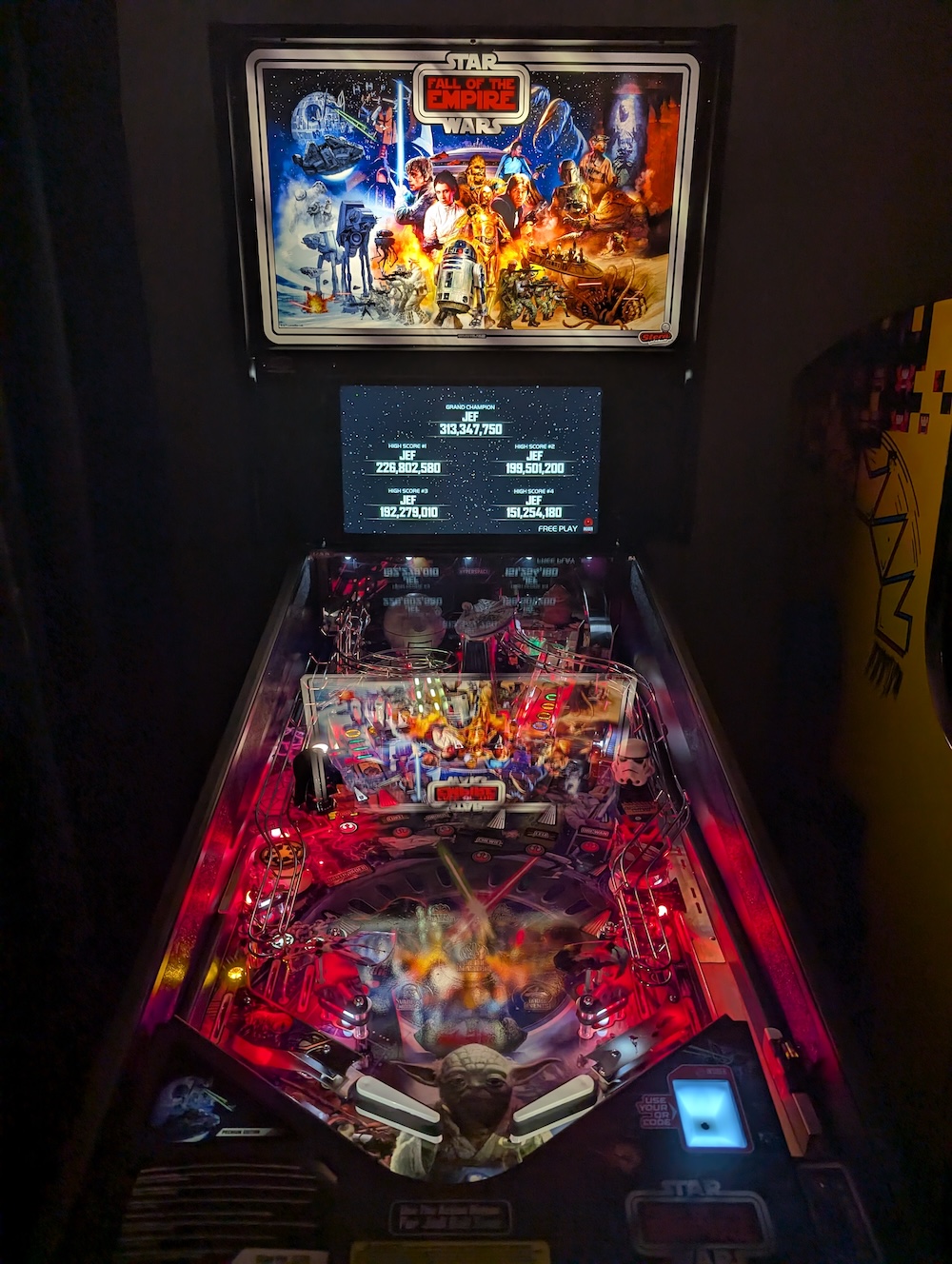I bought a pinball machine
posted by Jeff | Thursday, October 23, 2025, 11:24 PM | comments: 0Back in 2009, as we were packing up to move from Cleveland to Seattle, I regrettably sold my Jurassic Park pinball machine from 1993. When I bought it used in 2000, for a comparatively reasonable $2,000 I think, the inside smelled like a bar (read: cigarette smoke) but it operated fairly well. It required a little maintenance from time to time, but I really got to know it well. It was a huge hit at parties. I always said I would get another one someday, but I didn't realize that it would be 16 years.
I've favored experiences over stuff for years now. I think this approach to life has generally served me pretty well. I've made some big purchases for hobbies, usually in the service of making stuff. But this is something that is purely for entertainment. While there are a ton of used machines, and I still love the old JP machine, I wanted something totally new, from the box. There are just two manufacturers now, and Stern has the legacy and history of the old Sega and Data East machines. They launched a new platform, which they call Spike3, with a new Star Wars game, Fall of the Empire. Incredibly, the designer was one of three guys that designed the '93 JP machine! Stern also has the press used to mark the playfield boards for every one of those old machines. So this new thing has ties to the old thing. I decided that it was long overdue. I've been looking at the new machines every year at IAAPA, but never pulled the trigger.
I bought the premium version, which is a step up from the pro, but not as expensive as the limited edition. The pro lacks certain mechanical ramps, movement and the "Force" magnet. The LE has blue paint and more lights, but I like this one better. It has a very classic Vader and Luke with lightsabers illustration on the side. What they all have now is online accounts that save your stats and achievements, and you can scan your QR code on machines anywhere. For the home machine, you can add your accounts directly to the machine so you don't need to scan them. It's very cool. I'll write up a review of the machine eventually, but so far I really like it. It can get very fast, especially with various multi-ball situations.
I waited to write about it for about two weeks, because I had an issue with it. A short somewhere in the lighting was causing the controller for the lower part of the machine to keep resetting. I was able to narrow it down to one of the "general illumination" strings (i.e., playfield lights), and specifically a socket that got hot and seemed to be shorting out. I could still play it by unplugging these, but it meant the bottom half was dark. The distributor came back out today and replaced it, and everything was good.
It's not the only quality problem. Someone failed to put a wrench on the bolts around the coin door, and one had come completely off in shipping. I found the nut inside. There's also a bracket around the Death Star opening that is too narrow, so the ball doesn't make it in as much as it should. It sounds like this is a known problem, and some enterprising folks have used a Dremel to widen it. But they may end up shipping out replacements.
All things considered, the architecture of the modern machine is pretty clever. Some things are radically different, while others are the same as they were 30 years ago. And while I'm sure that some of the parts are made off-shore, the machine is mostly made in Chicago. American companies are still pretty good at making certain niche things, and this is definitely one of them. I don't give Stern a pass for the QC issues, especially given the cost of these very expensive toys, but they are remarkably mechanical and physical machines. It's not like a game console, which likely works or it doesn't.
And therein lies the biggest challenge for Stern. The machines tend to find their way into homes more than commercial settings. It's not that there aren't any arcades, but no one wants to maintain these things. And your average D&B is mostly redemption crap now. So the growth is among collectors in the home. Selling a commercial product to consumers is tricky. The expectations are different. Things like copy machines and coffee makers are expected to require maintenance, as are pinball machines. But consumers want stuff to just work.
The other interesting thing is that the software isn't actually complete. They aren't to v1.0 yet, and apparently that's normal these days. The rulebook has blank sections! I'm not sure how to feel about that.
Still, there is I think a certain level of satisfaction that people get maintaining these, and I remember that was true for the old JP machine. In particular, I remember having a problem with the switches in the ball chute. One of them didn't line up right, so the machine thought a ball was missing. It took a day of messing around with it to fix it, but it was satisfying. Now they use optical sensors, which are way more reliable.
The best part is that Simon is totally into it. Diana is too, though she's the undisputed Galaga queen. I can't wait to have people over, as I'm sure they'll congregate around it while I pour them cocktails. As I said, I'll review the game after I've had more time with it. For now, let me say that I'm thrilled to begin my second pinball era!
Comments
No comments yet.
